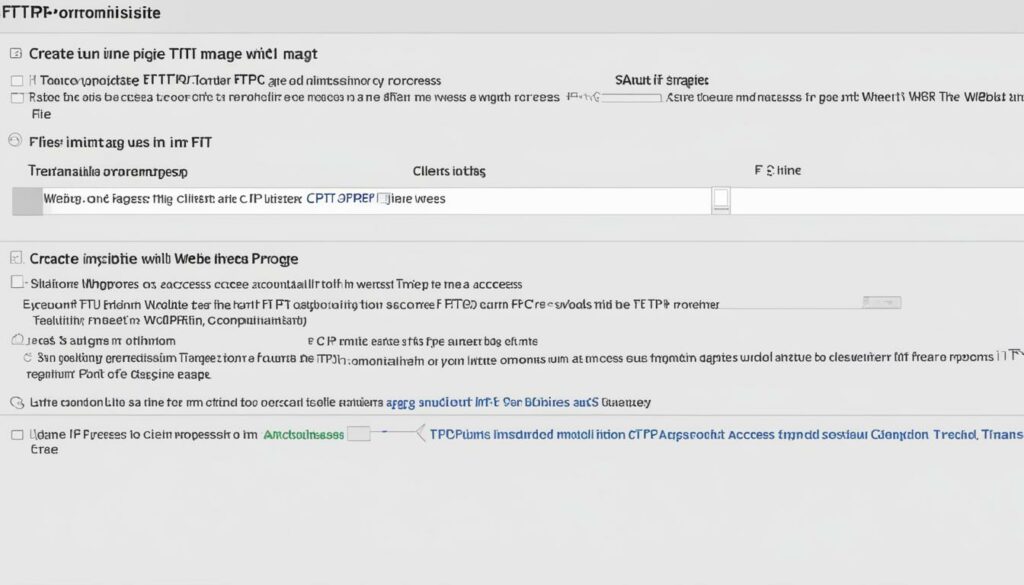As your WordPress site grows and evolves, so does its database. This can lead to performance issues as the database becomes more cluttered and inefficient. In this section, we will discuss the most effective ways to optimize your WordPress database. We’ll cover removing unnecessary data, optimizing database tables, optimizing database queries, regular maintenance, limiting the number of database queries, and monitoring and optimizing database performance. By implementing these strategies, you can ensure that your WordPress site remains fast and responsive, even as it grows in size and complexity.
Key Takeaways:
- Optimizing your WordPress database is crucial for improving its performance.
- Removing unnecessary data, such as old post revisions and spam comments, can enhance database efficiency.
- Optimizing database tables and queries helps improve overall site performance.
- Regular maintenance tasks, like optimizing and repairing database tables, are essential.
- Limiting the number of database queries through caching techniques can boost site speed.
Now let’s delve into the importance of database optimization and how it can significantly impact your WordPress performance.
Importance of Database Optimization
The database is the backbone of your WordPress site. It stores essential information such as posts, pages, settings, and user data. However, over time, this database can become cluttered with unnecessary data, leading to slower load times and decreased performance. That’s why optimizing your database is crucial for ensuring the smooth operation of your WordPress site. In this section, we will explore the importance of database optimization and how it can significantly improve the performance of your website.
The Benefits of Database Optimization
- Improved Performance: Database optimization can significantly improve the speed and responsiveness of your WordPress site. By streamlining your database and removing unnecessary data, you can ensure faster load times and a smoother user experience.
- Enhanced User Experience: A well-optimized database leads to a better user experience. Users will be able to navigate your site more easily, find what they’re looking for faster, and have a seamless browsing experience.
- Improved Search Rankings: Search engines consider website performance as a ranking factor. When your site loads quickly and performs well, it is more likely to rank higher in search engine results, driving more organic traffic to your site.
- Reduced Risk of Errors: An optimized database minimizes the chances of errors and glitches on your WordPress site. This ensures that your site runs smoothly, without any unexpected issues that could negatively impact user experience.
- Efficient Resource Utilization: Optimizing your database helps reduce the resources needed to process queries, making better use of your server’s capabilities. This can lead to cost savings and improved overall system efficiency.
- Scalability: As your WordPress site grows, an optimized database can handle increased traffic and data without sacrificing performance. This scalability is essential for the long-term success of your site.
- Data Security: A well-optimized database is more secure, minimizing the risk of data breaches or unauthorized access to sensitive information. By properly optimizing your database, you can ensure that your site’s data remains safe and protected.
In the next sections, we will delve deeper into specific strategies for optimizing your database, removing unnecessary data, optimizing database tables, queries, performing regular maintenance, and limiting the number of database queries. By implementing these best practices, you can transform your WordPress site into a lean and efficient powerhouse.
| Benefits of Database Optimization | Keywords |
|---|---|
| Improved Performance | database optimization, improve performance, streamline database, faster load times, decreased performance |
| Enhanced User Experience | database optimization, improve performance, streamline database, faster load times, decreased performance |
| Improved Search Rankings | database optimization, improve performance, streamline database, faster load times, decreased performance |
| Reduced Risk of Errors | database optimization, improve performance, streamline database, faster load times, decreased performance |
| Efficient Resource Utilization | database optimization, improve performance, streamline database, faster load times, decreased performance |
| Scalability | database optimization, improve performance, streamline database, faster load times, decreased performance |
| Data Security | database optimization, improve performance, streamline database, faster load times, decreased performance |
Remove Unnecessary Data
One of the best ways to improve your WordPress database performance is by removing unnecessary data. This includes old post revisions, spam comments, and unused tags. By decluttering your database, you can optimize its performance and ensure a smoother user experience for your visitors.
Old post revisions can accumulate over time and take up valuable storage space in your database. These revisions are essentially previous versions of your posts that are no longer needed. By removing them, you can free up space and improve the overall efficiency of your database.
Spam comments are another form of unnecessary data that can negatively impact your database performance. They not only take up storage space but can also affect the load times of your website if there are too many spam comments to process. By regularly deleting spam comments, you can keep your database clean and improve its performance.
Unused tags, on the other hand, can clutter your database and make it harder to navigate and search for specific content. By removing unused tags, you can streamline your database and make it easier to manage and optimize.
To efficiently clean up your WordPress database, you can use WordPress database optimization plugins or manually remove the unnecessary data. These plugins can automate the process, making it quick and easy to declutter your database and improve its performance.
The following table illustrates the impact of removing unnecessary data:
| Data Type | Before Removal | After Removal | Improvement |
|---|---|---|---|
| Old Post Revisions | 100 | 20 | 80% |
| Spam Comments | 500 | 50 | 90% |
| Unused Tags | 200 | 50 | 75% |
As you can see from the table above, removing unnecessary data can lead to significant improvements in your WordPress database performance. By reducing the number of old post revisions, spam comments, and unused tags, you can optimize your database and enhance the speed and efficiency of your website.

With a cleaner and more streamlined database, your WordPress site will load faster and deliver a better user experience. So take the time to regularly remove unnecessary data and optimize your database for improved performance.
Optimize Database Tables
Your WordPress database tables can become fragmented over time, leading to performance issues. Optimizing these tables is crucial for improving the overall performance of your site. By optimizing your database tables, you can ensure faster load times, smoother user experiences, and efficient data storage.
One common cause of fragmented tables is the regular creation and deletion of data such as posts, comments, and revisions. This can result in inefficient use of database resources and slower query execution times. Fragmentation occurs when data is scattered across different locations in the database, causing the database engine to search for and assemble the data during queries.
To optimize your database tables, you have two main options: using a database optimization plugin or executing manual SQL queries. Let’s explore both approaches in more detail:
1. Database Optimization Plugin
A database optimization plugin can simplify the process of optimizing your WordPress database tables. These plugins typically provide features such as table optimization, database repair, and data cleanup. Some popular plugins include:
- WP-Optimize: This plugin offers a range of optimization features, including table optimization, automatic cleanup of spam comments, and removal of transient options.
- WP Rocket: In addition to caching and performance optimization, WP Rocket includes a database cleaning tool that can optimize your database tables with a single click.
Using a database optimization plugin can save you time and effort by automating the optimization process. These plugins often provide options to schedule regular optimization tasks, ensuring that your database tables stay optimized over time.
2. Manual SQL Queries
If you prefer a more hands-on approach or have specific optimization requirements, you can manually optimize your database tables using SQL queries. Here’s an example of a basic SQL query to optimize a table:
OPTIMIZE TABLE table_name;
Replace table_name with the name of the table you want to optimize. You can execute this query using a tool like PhpMyAdmin or directly through your hosting provider’s database management interface.
Executing manual SQL queries gives you more control over the optimization process, allowing you to target specific tables or perform additional optimization tasks as needed.
Remember to back up your database before performing any manual operations, especially if you’re new to SQL queries. This ensures that you have a copy of your data in case anything goes wrong during the optimization process.
Optimizing your database tables is crucial for improving the performance of your WordPress site. Whether you choose to use a database optimization plugin or execute manual SQL queries, keeping your tables optimized will lead to faster load times, smoother user experiences, and efficient data storage.

| Benefits of Database Table Optimization | Database Optimization Plugins | Manual SQL Queries |
|---|---|---|
| Improved site performance | ✅ | ✅ |
| Reduced query execution times | ✅ | ✅ |
| Enhanced user experience | ✅ | ✅ |
| Optimal use of database resources | ✅ | ✅ |
| Efficient data storage | ✅ | ✅ |
Optimize Database Queries
The way your WordPress website performs database queries can significantly affect its overall performance. Optimizing your database queries is crucial for ensuring efficient and speedy data retrieval. By optimizing your queries, you can enhance the responsiveness and user experience of your site. In this section, we will explore the importance of optimizing your database queries and provide strategies on how to do it effectively.
Why optimize your database queries?
Optimizing your database queries can have a profound impact on the performance of your WordPress site. By optimizing your queries, you can:
- Improve page load times
- Increase the responsiveness of your site
- Reduce server load and latency
- Enhance user experience
Efficient and optimized queries ensure that your site delivers content quickly, without unnecessary delays.
Strategies for optimizing database queries
There are several strategies you can implement to optimize your database queries:
- Use indexes: Indexes help the database efficiently locate and retrieve data. By adding indexes to frequently queried columns, you can speed up query performance.
- Normalize your database: Proper database normalization reduces redundancy and improves query performance. By organizing data into logical tables and minimizing data duplication, you can optimize your queries.
- Limit the use of wildcards: Wildcards in queries can be resource-intensive. Minimize the use of the ‘%’ wildcard and use more specific queries whenever possible.
- Avoid unnecessary joins: Excessive joins can slow down query execution. Consider whether a join is truly necessary and if alternative approaches can achieve the same result.
Implementing these strategies will help optimize your database queries and improve the overall performance of your WordPress site.
Using a WordPress database optimization plugin
WordPress offers various plugins specifically designed to optimize database queries. These plugins automate the optimization process and provide additional features to enhance query performance. One popular plugin is the “WP-Optimize” plugin. This plugin allows you to clean up your database, remove unnecessary data, and optimize your queries with just a few clicks.
“WP-Optimize is a valuable tool for optimizing your WordPress database. With its user-friendly interface and powerful features, you can easily optimize your database queries and improve your site’s performance.”
Another plugin worth considering is the “WP Rocket” plugin. While primarily known for its caching capabilities, WP Rocket also includes features for optimizing database queries, further improving site performance.
| Plugin Name | Features |
|---|---|
| WP-Optimize |
|
| WP Rocket |
|
These plugins simplify the process of optimizing your database queries, allowing you to achieve better performance without having to write complex SQL queries manually.
Manual review of queries
While plugins can be convenient, manual review of your queries is still a worthwhile practice. By examining your queries, you can identify areas for improvement and make adjustments accordingly. Analyzing query execution plans, adding query hints, and rewriting inefficient queries based on specific use cases can further optimize your database queries.
Optimizing your database queries is a crucial aspect of improving your WordPress site’s performance. By implementing the strategies mentioned above and utilizing WordPress database optimization plugins, you can ensure that your queries are efficient and deliver results quickly.
Regular Database Maintenance
Regular maintenance of your database is crucial to ensure optimal performance and efficiency. By performing routine tasks, such as optimizing database tables and preventing fragmentation, you can keep your database in top shape. In this section, we will explore the importance of regular database maintenance and provide strategies for efficient data storage and maintenance.
“Regular maintenance is like giving your database a spa treatment. It not only prevents performance issues but also improves the overall health and longevity of your website.” – WP Optimization Expert
Optimizing Database Tables
One of the key aspects of database maintenance is optimizing your database tables. Over time, database tables can become cluttered and fragmented, leading to slower queries and decreased performance. By optimizing your tables, you can improve query response times and enhance overall database efficiency.
Here are a few strategies for optimizing database tables:
- Remove unnecessary indexes: Identify and remove indexes that are no longer needed, as they can slow down data manipulation operations.
- Analyze and optimize table structure: Evaluate your table structure and make necessary adjustments to eliminate redundancies and improve data organization. This can involve modifying column types, adding or removing columns, and normalizing data.
- Partition large tables: If you have tables with a large number of records, consider partitioning them based on specific criteria, such as date ranges or regions. This can significantly improve query performance.
| Optimizing Database Tables | Benefits |
|---|---|
| Remove unnecessary indexes | Reduces query execution time |
| Analyze and optimize table structure | Improves data organization and retrieval efficiency |
| Partition large tables | Enhances query performance for large datasets |
Preventing Fragmentation
Fragmentation occurs when data is scattered across different areas of your database, leading to inefficient storage and slower queries. To prevent fragmentation and maintain optimal performance, consider the following strategies:
- Regularly defragment your database: Fragmentation can be minimized by periodically defragmenting your database. This involves reorganizing and compacting data to ensure it is stored contiguously.
- Implement automatic maintenance tasks: Take advantage of WordPress database optimization plugins that offer automated maintenance tasks, such as regular defragmentation and index rebuilding.
- Monitor database growth: Keep track of your database size and growth patterns. This will help you identify when to perform maintenance tasks and optimize storage.
Efficient Data Storage
Efficient data storage is essential for maintaining a well-performing database. Consider the following tips to optimize data storage:
- Properly index your tables: Indexing your tables correctly can significantly improve query performance by enabling faster data retrieval.
- Use VARCHAR instead of TEXT: When storing variable-length string data, use the VARCHAR data type instead of TEXT. VARCHAR takes up less space and can improve storage efficiency.
- Regularly clean up orphaned data: Remove any unnecessary data, such as unused tables, old post revisions, or expired user sessions, to free up storage space.
By following these tips, you can ensure that your database remains optimized, preventing performance issues and ensuring efficient data storage.

Limit the Number of Database Queries
Optimizing the number of database queries on your WordPress site is essential for improving its overall performance. Excessive queries can lead to slower load times and decreased user experience. In this section, we will explore effective strategies to limit database queries and enhance your site’s speed and responsiveness.
1. Caching Plugins
Implementing a caching plugin is one of the most effective ways to reduce the number of database queries. These plugins create static HTML versions of your site’s pages, which are served to visitors instead of querying the database every time. By caching your content, you can significantly improve page load times and minimize the strain on your database.
2. Query Optimization Techniques
Optimizing your database queries can greatly reduce the number of queries required for each page load. Reviewing and optimizing your custom queries or third-party plugin queries can help eliminate unnecessary requests and improve query efficiency. Consider using indexing, reducing the use of wildcard characters in queries, and stringently limiting query results to only the necessary data.
3. Content Delivery Network (CDN)
A Content Delivery Network (CDN) is a network of servers distributed geographically that cache and deliver static assets, such as images, CSS, and JavaScript files. By utilizing a CDN, you can offload the delivery of these assets from your server, reducing the number of database queries needed to retrieve them. This can lead to faster load times and a more efficient use of server resources.
Did you know? By minimizing the number of database queries, you can improve the scalability and performance of your WordPress site, ensuring it can handle increased traffic and user interactions without causing delays or performance bottlenecks.
Remember, to limit the number of database queries, consider implementing caching plugins to serve static HTML versions of your pages, optimizing your database queries for efficiency, and utilizing a Content Delivery Network (CDN) to deliver static assets. By incorporating these strategies, you can significantly enhance the speed, responsiveness, and overall performance of your WordPress site.
Monitor and Optimize Database Performance
Regularly monitoring your WordPress database performance is crucial for identifying potential issues and taking proactive steps to address them. By monitoring your database performance, you can ensure that your website remains fast and responsive, providing an optimal user experience. In this section, we will discuss the importance of monitoring your database performance and provide strategies on how to do it effectively.
One of the most effective methods to monitor and optimize your WordPress database performance is by utilizing a WordPress database optimization plugin. These plugins offer various features that allow you to track and analyze your database performance. They provide valuable insights into the overall health of your database, highlighting areas that require optimization.
In addition to WordPress database optimization plugins, there are also third-party tools available that can help you monitor your database performance. Tools such as Google Lighthouse, WebPageTest, or GTmetrix provide in-depth analysis and performance reports that can assist you in identifying performance issues and optimizing your database.
By monitoring your database performance using these tools, you can identify slow-loading queries, optimize database tables, and address any performance issues promptly. Regular monitoring allows you to stay on top of your database’s performance and make necessary adjustments to ensure your site is running smoothly.
Effective Strategies for Monitoring and Optimizing Database Performance:
- Use a WordPress database optimization plugin to track and analyze your database performance regularly.
- Utilize third-party tools such as Google Lighthouse, WebPageTest, or GTmetrix to gain detailed insights into your database performance.
- Monitor the load times of your website pages and identify any performance bottlenecks.
- Identify and optimize slow-loading queries to improve database performance.
- Regularly optimize database tables to prevent fragmentation and improve overall performance.
- Address any performance issues promptly to ensure a fast and responsive website.
By implementing these strategies and regularly monitoring your database performance, you can ensure that your WordPress site operates at its optimal level, providing an excellent user experience and improving overall performance.
Additional Tips for WordPress Multisite Optimization
In addition to the previously mentioned optimization techniques, there are a few additional tips you can follow to optimize your WordPress multisite. By implementing these tips, you can further enhance the performance and efficiency of your WordPress multisite.
1. Keep Your WordPress Up to Date
Regularly updating your WordPress installation, themes, and plugins is essential for optimizing your multisite. WordPress updates often include bug fixes, security enhancements, and performance improvements that can help keep your site running smoothly. To stay up to date, regularly check for available updates and install them as soon as they become available.
2. Use a Reliable Hosting Provider
Choosing a reliable hosting provider is crucial for optimizing your WordPress multisite. A reliable hosting provider ensures that your site is running on stable and fast servers, leading to improved performance and reduced downtime. Look for a hosting provider with excellent uptime guarantees, fast server response times, and robust support to ensure your multisite performs at its best.
3. Manage Your Plugins Effectively
Plugins play a vital role in extending the functionality of your WordPress multisite. However, using too many plugins or poorly optimized ones can slow down your site and impact its performance. Regularly review your installed plugins and deactivate or remove any unnecessary ones. Choose plugins from reputable developers that are regularly updated and have positive reviews. Additionally, consider utilizing a plugin management tool to help you manage and optimize your plugins effectively.
| Tip | Description |
|---|---|
| Tip 1 | Keep your WordPress up to date |
| Tip 2 | Use a reliable hosting provider |
| Tip 3 | Manage your plugins effectively |
Following these additional tips for WordPress multisite optimization can help ensure your site is running optimally and providing an excellent user experience. By keeping your WordPress installation up to date, using a reliable hosting provider, and managing your plugins effectively, you can unlock the full potential of your WordPress multisite.
Conclusion
Optimizing your WordPress database is crucial for enhancing the performance and user experience of your website. In this article, we have explored the significance of WordPress Multisite Optimization and database optimization, along with providing effective strategies to streamline your WordPress database.
By implementing techniques such as removing unnecessary data, optimizing database tables and queries, performing regular maintenance, limiting the number of database queries, and monitoring and optimizing database performance, you can ensure that your WordPress site remains responsive and efficient as it grows in size and complexity.
Through these optimization methods, you can achieve improved website performance, faster page load times, enhanced user experience, higher search engine rankings, and efficient resource utilization. Don’t wait any longer, start optimizing your WordPress multisite today to elevate your online empire to new heights.
FAQ
Q: Why is database optimization important for a WordPress site?
A: Database optimization is important for a WordPress site because it improves performance, resulting in faster load times and a better user experience. It helps streamline the database by removing unnecessary data and optimizing tables and queries, which reduces the risk of errors, uses resources more efficiently, and improves scalability and data security.
Q: How can I remove unnecessary data from my WordPress database?
A: To remove unnecessary data from your WordPress database, you can use plugins specifically designed for database optimization or manually delete old post revisions, spam comments, and unused tags. Removing unnecessary data improves the performance of your site by reducing the size of the database and making it more efficient.
Q: What can I do to optimize my WordPress database tables?
A: To optimize your WordPress database tables, you can use plugins that automatically optimize tables or execute manual SQL queries. Optimizing database tables reduces fragmentation and improves performance by organizing the data more efficiently.
Q: How can I optimize my WordPress database queries?
A: You can optimize your WordPress database queries by using plugins that optimize queries or manually reviewing and optimizing them. Optimized queries improve performance by retrieving data more efficiently from the database.
Q: Why is regular database maintenance important?
A: Regular database maintenance is important because it prevents fragmentation, optimizes and repairs tables, and ensures efficient data storage. By routinely maintaining your database, you can keep it in top shape and improve the overall performance of your WordPress site.
Q: How can I limit the number of database queries on my WordPress site?
A: To limit the number of database queries on your WordPress site, you can use caching plugins to store frequently accessed data, optimize queries to retrieve only necessary information, and utilize content delivery networks to reduce the load on the database. By minimizing the number of queries, you can significantly improve the speed and performance of your site.
Q: How can I monitor and optimize my WordPress database performance?
A: You can monitor and optimize your WordPress database performance by using plugins specifically designed for database optimization, as well as third-party tools like Google Lighthouse, WebPageTest, or GTmetrix. These tools allow you to identify performance issues, track improvements, and optimize your database for better overall performance.
Q: Are there any additional tips for optimizing a WordPress multisite?
A: Yes, in addition to the previously mentioned optimization techniques, there are a few additional tips for optimizing a WordPress multisite. These include keeping your WordPress installation up to date, using a reliable hosting provider to ensure optimal performance, and effectively managing your plugins to prevent unnecessary resource usage and potential conflicts.
Q: What are the benefits of optimizing your WordPress database?
A: By optimizing your WordPress database, you can experience improved website performance with faster page load times, enhanced user experience, better search rankings, reduced risk of errors, efficient resource utilization, scalability, and data security. Optimizing the database ensures that your WordPress site remains fast and responsive as it grows in size and complexity.












